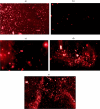Yttrium oxide nanoparticles ameliorates calcium hydroxide and calcium titanate nanoparticles induced genomic DNA and mitochondrial damage, ROS generation and inflammation
- PMID: 38844752
- PMCID: PMC11156978
- DOI: 10.1038/s41598-024-62877-4
Yttrium oxide nanoparticles ameliorates calcium hydroxide and calcium titanate nanoparticles induced genomic DNA and mitochondrial damage, ROS generation and inflammation
Abstract
Calcium hydroxide (Ca(OH)2NPs), calcium titanate (CaTiO3NPs) and yttrium oxide (Y2O3NPs) nanoparticles are prevalent in many industries, including food and medicine, but their small size raises concerns about potential cellular damage and genotoxic effects. However, there are very limited studies available on their genotoxic effects. Hence, this was done to investigate the effects of multiple administration of Ca(OH)2NPs, CaTiO3NPs or/and Y2O3NPs on genomic DNA stability, mitochondrial membrane potential integrity and inflammation induction in mouse brain tissues. Mice were orally administered Ca(OH)2NPs, CaTiO3NPs or/and Y2O3NPs at a dose level of 50 mg/kg b.w three times a week for 2 weeks. Genomic DNA integrity was studied using Comet assay and the level of reactive oxygen species (ROS) within brain cells was analyzed using 2,7 dichlorofluorescein diacetate dye. The expression level of Presenilin-1, tumor necrosis factor-alpha (TNF-α) and Interleukin-6 (IL-6) genes and the integrity of the mitochondrial membrane potential were also detected. Oral administration of Ca(OH)2NPs caused the highest damage to genomic DNA and mitochondrial membrane potential, less genomic DNA and mitochondrial damage was induced by CaTiO3NPs administration while administration of Y2O3NPs did not cause any remarkable change in the integrity of genomic DNA and mitochondrial membrane potential. Highest ROS generation and upregulation of presenilin-1, TNF-α and IL-6 genes were also observed within the brain cells of mice administrated Ca(OH)2NPs but Y2O3NPs administration almost caused no changes in ROS generation and genes expression compared to the negative control. Administration of CaTiO3NPs alone slightly increased ROS generation and the expression level of TNF-α and IL-6 genes. Moreover, no remarkable changes in the integrity of genomic DNA and mitochondrial DNA potential, ROS level and the expression level of presenilin-1, TNF-α and IL-6 genes were noticed after simultaneous coadministration of Y2O3NPs with Ca(OH)2NPs and CaTiO3NPs. Coadministration of Y2O3NPs with Ca(OH)2NPs and CaTiO3NPs mitigated Ca(OH)2NPs and CaTiO3NPs induced ROS generation, genomic DNA damage and inflammation along with restoring the integrity of mitochondrial membrane potential through Y2O3NPs scavenging free radicals ability. Therefore, further studies are recommended to study the possibility of using Y2O3NPs to alleviate Ca(OH)2NPs and CaTiO3NPs induced genotoxic effects.
Keywords: Calcium hydroxide; Calcium titanate; Genotoxicity; Mitochondrial membrane potential; Nanoparticles; ROS generation; Yttrium oxide.
© 2024. The Author(s).
Conflict of interest statement
The authors declare no competing interests.
Figures




Similar articles
-
Calcium hydroxide nanoparticles induce cell death, genomic instability, oxidative stress and apoptotic gene dysregulation on human HepG2 cells.Sci Rep. 2025 Jan 23;15(1):2993. doi: 10.1038/s41598-025-86401-4. Sci Rep. 2025. PMID: 39849036 Free PMC article.
-
Genotoxicity and oxidative stress induction by calcium hydroxide, calcium titanate or/and yttrium oxide nanoparticles in mice.Sci Rep. 2023 Nov 10;13(1):19633. doi: 10.1038/s41598-023-46522-0. Sci Rep. 2023. PMID: 37949924 Free PMC article.
-
Alleviation of calcium hydroxide nanoparticles induced genotoxicity and gastritis by coadministration of calcium titanate and yttrium oxide nanoparticles in mice.Sci Rep. 2023 Dec 12;13(1):22011. doi: 10.1038/s41598-023-49303-x. Sci Rep. 2023. PMID: 38086889 Free PMC article.
-
Calcium and Reactive Oxygen Species Signaling Interplays in Cardiac Physiology and Pathologies.Antioxidants (Basel). 2023 Feb 2;12(2):353. doi: 10.3390/antiox12020353. Antioxidants (Basel). 2023. PMID: 36829912 Free PMC article. Review.
-
Fluorescent protein transgenic mice for the study of Ca2+ and redox signaling.Free Radic Biol Med. 2022 Mar;181:241-250. doi: 10.1016/j.freeradbiomed.2022.02.011. Epub 2022 Feb 12. Free Radic Biol Med. 2022. PMID: 35158029 Free PMC article. Review.
Cited by
-
Erbium oxide nanoparticles induce potent cell death, genomic instability and ROS-mitochondrial dysfunction-mediated apoptosis in U937 lymphoma cells.Naunyn Schmiedebergs Arch Pharmacol. 2025 Aug;398(8):11027-11039. doi: 10.1007/s00210-025-03962-x. Epub 2025 Mar 12. Naunyn Schmiedebergs Arch Pharmacol. 2025. PMID: 40072553 Free PMC article.
-
Calcium hydroxide nanoparticles induce cell death, genomic instability, oxidative stress and apoptotic gene dysregulation on human HepG2 cells.Sci Rep. 2025 Jan 23;15(1):2993. doi: 10.1038/s41598-025-86401-4. Sci Rep. 2025. PMID: 39849036 Free PMC article.
-
Y2O3NPs induce selective cytotoxicity, genomic instability, oxidative stress and ROS mediated mitochondrial apoptosis in human epidermoid skin A-431 Cancer cells.Sci Rep. 2025 Jan 9;15(1):1543. doi: 10.1038/s41598-024-82376-w. Sci Rep. 2025. PMID: 39789066 Free PMC article.
References
-
- Kumar MS. Nano Science and Nanotechnology: Journey from Past to Present and Prospect in Veterinary Science and Medicine. Nanoscience. 2014;2(1):79–83.
-
- Jacobsen NR, Pojana G, White P, Møller P, Cohn CA, Korsholm KS, Vogel U, Marcomini A, Loft S, Wallin H. Genotoxicity, cytotoxicity, and reactive oxygen species induced by single-walled carbon nanotubes and C(60) fullerenes in the FE1-Mutatrade markMouse lung epithelial cells. Environ. Mol. Mutagen. 2008;49(6):476–478. doi: 10.1002/em.20406. - DOI - PubMed
-
- Ambrosi M, Dei L, Giorgi R, Neto C, Baglioni P. Colloidal particles of Ca(OH)2: Properties and applications to restoration of frescoes. Langmuir. 2001;17(14):4251–4255. doi: 10.1021/la010269b. - DOI
-
- Maroneze M, Zepka L, Vieira J, Queiroz M, JacobLopes E. A tecnologia de remoção de fósforo: Gerenciamento do elemento em resíduos industriais. Ambiente e Agua. 2014;9:445–558.
MeSH terms
Substances
LinkOut - more resources
Full Text Sources

